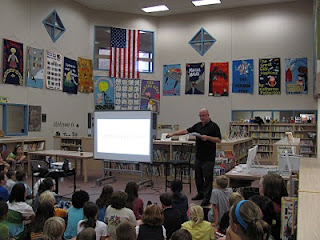
I have been fortunate enough to take part in a unique learning opportunity. Along with five other teachers in my building, I will be participating in a year-long learning experience with
PLP (Powerful Learning Practice) facilitators. What makes this a truly unique opportunity is that the six of us will be joining with other groups of teachers from across the country to think about 21st century learning / literacy practices in our classrooms and our schools.
Our first meeting will be a face to face meeting with all the participants on October 1 at our school. As that day-long experience is approaching, I started to reflect on where I am personally with my own thinking in regard to 21st century learning / literacy, and also how I have incorporated that thinking into our regular classroom routines.
I personally use several Web 2.0 tools on a regular basis -- socializing on
Facebook, following topics of interest to me on
Twitter, maintaining a blog about children's books here with Bill at Literate Lives, keeping abreast of other bloggers on my
Google Reader, bookmarking topics of interest on my
delicious.com account to refer back to at a later date, tracking my own reading (as well as the reading of others) using the
Good Reads site, and using a
wiki with my students as another platform for composing/revising/editing pieces.
What I've come to realize is that I personally have a difficult time balancing all those tools and all the work that goes into being a classroom teacher. One of my biggest hopes for this year is that I will learn how to integrate these tools in a way that is more efficient and meaningful. When I use those tools I mentioned one at a time, it could easily take an entire morning or afternoon, and that isn't even taking into account the fact that I will most likely get sidetracked by something else of interest while I am perusing these tools.
We've been asked to do some "pregame" activities before our first meeting next Friday. There have been many amazing videos to watch, blog posts to read, and several thoughtful articles all focused on the topic of Web 2.0 tools in the school/classroom, and whether or not we are giving our students the best tools to be successful in the world in which they live.
One of the videos I watched focused on the idea of "connectivism" -- all the connected ways in which students can learn. This video and others focus on some different roles for teachers. The ones that really spoke to me were the ideas of teachers as learning architects, teachers as modelers, and teachers as learning concierges. The point was made that we can't "do" school the way we've always done it; we need to rethink the ways we enable students to learn.
But I think the biggest concept I am taking away from what I've read and seen so far, are the 3 C's -- contribute, create, and collaborate. These words are what Web 2.0 tools allow students to do. Learning should no longer be a passive activity, but rather one in which the students actively participate. They need to create things on Web 2.0, they need to contribute to ideas that are already out on Web 2.o, and they need to collaborate with others using Web 2.0 as their toolbox.
Now, if I can just figure out that balance thing when it comes to Web 2.0 tools, that would be great! My goal will be to increase my efficiency as I use these tools, and to help my students see the power of being part of a larger community than just our classroom when it comes to learning. I am grateful to be learning alongside some very smart people as we all tackle these type of issues and are introduced by
PLP to a world of new possibilities.
















